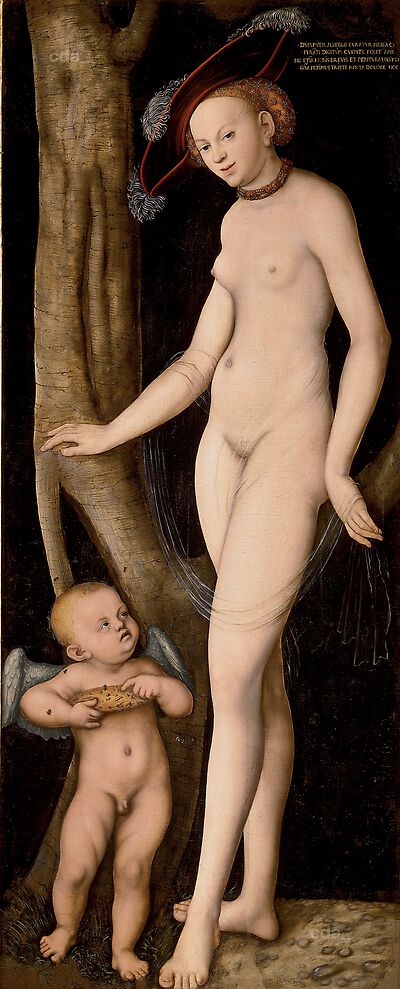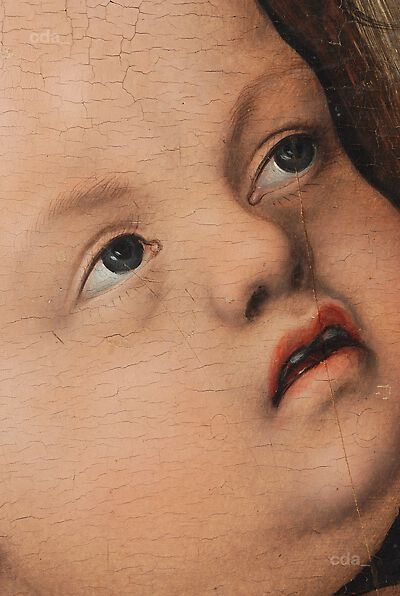Support
- six wooden boards of equal widths arranged vertically
- our findings are instead compatible with lime wood, a species found in many of the painter’s works, and, to a certain extent, with beech wood – a hard wood, but easily prey to woodworm -, one of the species of wood preferred by Cranach in the 1520s and 1530s. At any rate, because of the support’s state of degradation dendrochronogical analysis could not be carried out to attempt to date the work.[Poldi 2010, 115, 120 Fn. 4]
Ground and Imprimatura
- white ground containing calcium and strontium [1] (calcium carbonate), perhaps covered with a layer of white priming to guarantee a water-proof, reflective background (regular presence of lead).
[1] The variations in the ratio between strontium (a possible substitute for calcium at a molecular level) and calcium allowed us to establish in which specific areas the ground is covered by paint layers of varying thickness (higher values for ratio).
[Poldi 2010, 117, 121, fn. 14]
Underdrawing
The underdrawing is partially legible with the naked eye. It consists exclusively of outlines and is only partially discernible under the profiles of the figures. In addition it also describes the details in the hands and faces. Executed in a diluted grey-black medium, perhaps the rest was covered by the black background paint which extends to the edge of the figures. A reading is further complicated by the fact that the artist reinforced some of the contours during the finishing stage. Moreover, there is a series of very fluid lines that follow the shape of Venus' arms and legs and mark some of the areas of her chest, which appear to have been made with a paint brush: they indicate the figure's original location, with a pose similar to the present one. Unlike for Cupid – where the lack of these signs suggest a preparatory cartoon or template was used – it would seem that for the larger figure the painter attempted to fill out the space of the panel by sketching out the figure he had in mind, without any intermediate stages in the process. The fact that similar traces are missing in Venus’ face might instead indicate that the artist proceeded to paint the goddess guided by a preparatory drawing on paper, a common practice in portraiture.
Infrared reflectography [1] shows other signs of sketching with a paint brush under Venus' hairnet [...]
There is no underdrawing for the letters ‘W.A.F.’
Reflectography failed to recover the inscription with the date for the work, which sources [2] say is located on the trunk close to the serpent signature-motif.
[1] A digital camera (CCD silicium detector) was used to execute infrared reflectography (IRR, between 0.8 and 1 micron) and false colour infrared reflectography (IRC); it was also used to take photographs under diffused and raking light and for macrophotographs. IRR analyses were then repeated with a CEDIP JADE SWIR J 220 telecamera and MCT detector (reflectography in wide band 0.8-2.5 microns), configured as a scanning system.
[2] See entry and essay by Kristina Hermann Fiore on the painting in this catalogue.
[Poldi 2010, 117-118, 121, fn. 15, 18]
Paint Layers and Gilding
- the painted surface extends to the edge of the panel
[...] the palette chosen by the painter, which investigation reveals[1] to be quite limited as concerns the pigments used, as well as by his choice of simple mixtures and layerings. Greyish-brown rather than brown brushstrokes were employed to paint the bare and leafless tree trunk - adding black pigment to brown earths, in order to better suit the background - exploiting thus the white ground that showed through. [...] the grassy vegetation beneath Cupid's feet [consists of] some verdigris [2] with lead white. The depiction of the ground is also rather simple: the pebbles were outlined and then covered with a grey and white scumble, shadows were applied and the contours were then blurred employing black paint.
In the flesh paint an admixture of lead white and vermilion was used [3] with either ochre or earth and black for the shadows [4]. Raking light shows the highlights were added last. Black was employed to emphasize the veins on Venus' temples. Her lips contain in addition to vermilion red lake extracted from madder (Rubia tinctoria)[5]. A similar mixture but with the addition of black, for the purpose of modulating shading, was used to paint the hat.
Cupid's wings were painted with azurite using white for the hatching on the feathers. Yellow ochre was used for the honeycomb and lead-tin yellow was used for the inscription and a small amount for the hair. Brown earth (with no manganese) was used to produce the dark spots. The same brown and black pigments were used for the bees.
The black background contains a high quantity of zinc. Due to the consistent ratio of zinc to iron it may be assumed that the artist used an earth pigment rich in zinc [6] and black pigments.[7]
[1] Tests conducted on more than fifty measurement points consisted in diffused reflectance spectroscopy in the visible range (vis-RS), aimed at recognizing many inorganic and organic pigments present in the surface layer, and in energy dispersive X-ray fluorescence spectrometry (EDXRF or XRF), which permits the detection of the chemical elements present in the layers of paint as far as the ground, without having to take samples. The associated use of such techniques is commonly known to allow for a reconstruction of simple stratigraphic sequences. For vis-RS, a Minolta CM 2600d spectrophotometer equipped with an internal integrating sphere, geometry d/8, spectral range 360-740 nm, and spectral resolution 10 nm, 3mm diameter measurement area, was used. For the EDXRF we used a Tracer Turbo spectrometer manufactured by Bruker, with an X-ray tube (tension equal to 40 kV, current 0.022 mA) equipped with a silver target, SDD detector, operating on a similar measurement area; time required for measurement was 40s. For a description of the methodologies of the tests cited, see the first section in [Poldi, Villa 2006]
[2] The presence of cupric acetate (verdigris, grünspan in documents for Cranach) is certified by the spectrum vis-RS with an absorption band of 700-720 nm. This is the type of green that Cranach used most, although in some of his works he also used the more precious malachite.
[3]We cannot safely say whether it is mineral cinnabar (mercury sulphide) or artificial vermilion.
[4] When black is used for the flesh tone and tree trunk, the signs of the brushstrokes are typically left visible.
[5] The presence of madder lake is proven by the absorption bands at approximately 510 and 550 nm in vis-RS spectra (reference in [Poldi 2008]).
[6] I have found no other identifications of zinc-rich earth in Cranach (and thanks to vis-RS analysis, we can also exclude that zinc is due to the presence of zinc white used by conservators), a fact that could indicate the provenance of the material. Similar types of earth were observed in a number of paintings from Italy, especially beginning in the early 16th century (in several of Perugino's later paintings, and occasionally in those of some Venetian painters, including Cima da Conegliano, Lorenzo Lotto, Liberale da Verona, Giovanni Martini da Udine); but examples are known of in Tuscany on panels from the 14th century. For references: [Poldi, Bonizzoni 2009, 141-142, Fn. 19];[The Perugino's Palette 2004]
[7] It is unclear whether the black pigment is of plant origin (unquestionably the one used most by Cranach) or of animal origin, i.e. obtained from charred bone. What is interesting is the absence of substantial quantities of verdigris, generally used in black pigments as a siccative medium and to thicken the mixture: here and in other areas analysed (except for the greens and the blues) the rather low copper counts could actually refer to impurities (accidental presences) between the preparatory layers.
[Poldi 2010, 115-117, 120, 121 fn. 6-12]
- examined by Gianluca Poldi


